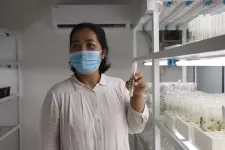(Press-News.org) Brigham researchers found that participation in a housing program was associated with fewer outpatient visits, improved physical and mental health, and stronger connections to their primary care clinics and care team.
Lack of safe and affordable housing is a critical issue in the United States and creates immense challenges for patients’ health, well-being, and ability to access care. Investigators from Brigham and Women’s Hospital, a founding member of the Mass General Brigham healthcare system, evaluated data from a social determinants of health screening and housing intervention program initiated in 2018 to help prevent homelessness and improve health care utilization and outcomes.
They found that in this primary-care-based program for patients who were unhoused, facing eviction, or living in unsafe housing conditions, those who received integrated support from the program’s care team had fewer outpatient visits, reported better physical and mental health, and felt more connected to their health care clinic and clinical team. The results are published in Health Affairs.
“It is very hard to get a patient’s blood pressure under control if they are worried about where they are going to sleep,” said the study’s lead author MaryCatherine Arbour, MD, MPH, the medical director of the social care team at Brigham and Women’s Hospital’s Primary Care Center. “A person’s health is extremely at risk if their housing is unstable. And since the pandemic, there has been an enormous increase in housing needs.”
In 2018, Brigham and Women’s Hospital began screening every MassHealth patient to address social determinants of health (SDoH), a term for nonmedical conditions that influence a person’s health, such as housing, education, employment and transportation access. ,The Brigham’s 14 primary care sites all conduct SDoH screening annually for every MassHealth patient. Four of those practices have expanded the screening to all primary care patients. The housing crisis is acutely evident in these screenings. Housing referrals fielded in this screening jumped from 20 per month in 2020 to 350 per month in 2023.
As part of this program, a Social Care Team, including housing advocates, address patients’ social needs in partnership with clinicians. Patients with a need for housing who are referred by staff or their doctor receive housing information from a Community Resource Specialist, and a subset of patients with imminent eviction risk or unhealthy conditions receive more specialized and intensive support from a housing advocacy team. Housing Advocates support patients for six months by addressing their housing needs and helping them with clinical care navigation and management. The care team works with a variety of community partners, including legal representation, to help find housing solutions.
“What makes this program special is that it is embedded in primary care and uses a triaged approach to identify housing types that are more likely to be affecting someone's health,” said Arbour. “It is a unique, integrated approach that partners community resource specialists and community health workers with the primary care team and partners the primary care team with community-based partners, including legal partners.”
To evaluate the program’s impact, Arbour and co-authors conducted a mixed-method, retrospective cohort evaluation study and looked at a sample of 1,139 patients over age 18 with housing-related needs who enrolled in the program between October 2018 and March 2021. The cohort was mainly comprised of female, non-white, and non-English-speaking MassHealth patients with more chronic conditions and higher emergency room use than the general population. The evaluation looked at associations between patients’ participation in the program and their utilization of health care services and chronic disease management. It also reviewed patient charts for data on housing issues, services, and outcomes, and conducted interviews that included questions about their living situations, health status, and social supports.
Participation in the program was linked to 2.5 fewer primary care visits and 3.6 fewer outpatient visits per year, including fewer social work, behavioral health, psychiatry, and urgent care visits. Patients also expressed mental and physical health benefits as a result of being placed in new housing, and many felt a closer connection to their primary care clinics and teams, partially due to the compassionate guidance received from the housing advocates. Another outcome was that often the first housing solution for the patient was not stable or healthy, which speaks to the complex magnitude of the unaffordable housing situation.
“The reduction in outpatient care was driven mostly by less urgent care, behavioral health, and social work utilization which suggests that the program is having important effects on mental health and behavioral health,” said Arbour. “Our housing advocates are amazing. Their ability to connect with patients in very stressful situations and provide them with empathy, respect, and compassion makes a big difference.”
The study’s limitations included a small sample size, short-term follow up, restricted data set, and self-reported data. The investigators also recognize that the program’s interventions do not address the root causes of housing insecurity and health disparities.
With primary care burnout on the rise, the research team plans to next explore the effects of a housing program on clinical staff and providers to see if it might also be associated with feeling more supported in confronting distressing situations with patients.
“Being unhoused or at risk of homelessness is incredibly stressful and detrimental for mental health,” said Arbour. “The most compelling aspect of the study to me was hearing the patients’ stories and reflections. They not only felt their physical and mental health improved as a result of the program, but they felt a sense of belonging and truly cared for by their primary care clinic.”
Authorship: Additional authors include Placidina Fico, Sidney Atwood, Na Yu, Lynn Hur, Maahika Srinivasan, and Richard Gitomer.
Paper cited: Arbour, M. et al. “Primary Care-Based Housing Program Reduced Outpatient Visits; Patients Reported Mental and Physical Health Benefits.” Health Affairs, DOI: 10.1377/hlthaff.2023.01046
END
Primary care housing intervention linked to improved patient health outcomes
Brigham researchers found that participation in a housing program was associated with fewer outpatient visits, improved physical and mental health, and stronger connections to their primary care clinics and care team.
2024-02-05
ELSE PRESS RELEASES FROM THIS DATE:
MSU researchers find early, promising glioblastoma treatment
2024-02-05
MSU has a satellite uplink/LTN TV studio and Comrex line for radio interviews upon request.
EAST LANSING, Mich. – A team of Michigan State University scientists has unveiled a potential game-changer in the fight against glioblastoma, the most common and currently incurable form of brain cancer.
A team of Michigan State University scientists has unveiled a potential game-changer in the fight against glioblastoma, the most common and currently incurable form of brain cancer.
Their weapon of choice? ...
Are body temperature and depression linked? Science says, yes
2024-02-05
People with depression have higher body temperatures, suggesting there could be a mental health benefit to lowering the temperatures of those with the disorder, a new UC San Francisco-led study found.
The study, publishing today in Scientific Reports, doesn’t indicate whether depression raises body temperature or a higher temperature causes depression. It’s also unknown whether the higher body temperature observed in people with depression reflects decreased ability to self-cool, increased generation of heat from metabolic processes or a combination of both.
Researchers analyzed data from more than 20,000 international ...
Persons diagnosed with PCOS face 8-fold increase in suicide risk
2024-02-05
Embargoed for release until 5:00 p.m. ET on Monday 5 February 2024
Annals of Internal Medicine Tip Sheet
@Annalsofim
Below please find summaries of new articles that will be published in the next issue of Annals of Internal Medicine. The summaries are not intended to substitute for the full articles as a source of information. This information is under strict embargo and by taking it into possession, media representatives are committing to the terms of the embargo not only on their own behalf, but also ...
Mental health care during the COVID-19 era remains inaccessible to many distressed US adults
2024-02-05
U.S. adults experienced considerable psychological distress and adverse mental health effects as a result of the COVID-19 pandemic according to a study at Columbia University Mailman School of Public Health and Columbia University Irving Medical Center. Based on insurance claims, mental health care provider surveys, and electronic health records the research further revealed a decline in in-person outpatient mental health visits during the acute phase of the pandemic. Findings are reported ...
Magnesium protects tantalum, a promising material for making qubits
2024-02-05
UPTON, NY—Scientists at the U.S. Department of Energy’s (DOE) Brookhaven National Laboratory have discovered that adding a layer of magnesium improves the properties of tantalum, a superconducting material that shows great promise for building qubits, the basis of quantum computers. As described in a paper just published in the journal Advanced Materials, a thin layer of magnesium keeps tantalum from oxidizing, improves its purity, and raises the temperature at which it operates as a superconductor. All three may increase tantalum’s ability ...
From Colombia to Laos: protecting crops through nanotechnology
2024-02-05
In a recent breakthrough, DNA sequencing technology has uncovered the culprit behind cassava witches’ broom disease: the fungus genus Ceratobasidium.
The cutting-edge nanopore technology used for this discovery was first developed to track the COVID-19 virus in Colombia, but is equally suited to identifying and reducing the spread of plant viruses. The findings, published in Scientific Reports, will help plant pathologists in Laos, Cambodia, Vietnam and Thailand protect farmers’ valued cassava harvest.
“In Southeast ...
New guideline details acute pain management strategies for adolescent, adult dental patients
2024-02-05
CHICAGO, Feb. 5, 2024 – Nonsteroidal anti-inflammatory drugs (NSAIDs) taken alone or along with acetaminophen are recommended as first-line treatments for managing short-term dental pain in adults and adolescents aged 12 or older, according to a new clinical practice guideline developed by the American Dental Association (ADA), the University of Pittsburgh School of Dental Medicine and the Center for Integrative Global Oral Health at the University of Pennsylvania School of Dental Medicine. The guideline has been endorsed by the ADA and is now available in the February issue of The Journal ...
How ‘deaths of despair’ differ by race and ethnicity
2024-02-05
COLUMBUS, Ohio – White Americans are more likely than Black and Hispanic people in the United States to experience “deaths of despair” even though they are less likely to suffer from severe psychological distress, a new study finds.
The results suggest that, for some reason, whites are more vulnerable to the damaging effects of psychological distress than Blacks or Hispanics, said Hui Zheng, lead author of the study and professor of sociology at The Ohio State University. Zheng is currently on leave at the University of Hong Kong.
“The white population has an increasing trend of despair-related mortality after 2000,” Zheng said. ...
Understanding how soil traps carbon
2024-02-05
EVANSTON, Ill. — When carbon molecules from plants enter the soil, they hit a definitive fork in the road.
Either the carbon gets trapped in the soil for days or even years, where it is effectively sequestered from immediately entering the atmosphere. Or it feeds microbes, which then respire carbon dioxide (CO2) into the ever-warming environment.
In a new study, Northwestern University researchers determined the factors that could tip plant-based organic matter in one direction or the other.
By combining laboratory experiments and molecular modeling, researchers ...
USC researchers uncover biological circuit that protects plants from extreme conditions
2024-02-05
Climate change is already harming agricultural yields and may one day pose a significant threat to the world’s food supply. Engineering more resilient crops, including those able to thrive in the face of drought or high soil salinity levels, is an increasingly urgent need.
A new study from the Keck School of Medicine of USC, funded in part by the National Institutes of Health, reveals details about how plants regulate their responses to stress that may prove crucial to those efforts. Researchers found that plants use their circadian clocks to respond to changes in external water and salt levels throughout the day. That same circuitry—an ...
LAST 30 PRESS RELEASES:
This self-powered eye tracker harnesses energy from blinking and is as comfortable as everyday glasses
Adverse prenatal exposures linked to higher rates of mental health issues, brain changes in adolescents
Restoring mitochondria shows promise for treating chronic nerve pain
Nature study identifies a molecular switch that controls transitions between single-celled and multicellular forms
USU chemists' CRISPR discovery could lead to single diagnostic test for COVID, flu, RSV
Early hominins from Morocco reveal an African lineage near the root of Homo sapiens
Small chimps, big risks: What chimps show us about our own behavior
We finally know how the most common types of planets are created
Thirty-year risk of cardiovascular disease among healthy women according to clinical thresholds of lipoprotein(a)
Yoga for opioid withdrawal and autonomic regulation
Gene therapy ‘switch’ may offer non-addictive pain relief
Study shows your genes determine how fast your DNA mutates with age
Common brain parasite can infect your immune cells. Here's why that's probably OK
International experts connect infections and aging through cellular senescence
An AI–DFT integrated framework accelerates materials discovery and design
Twist to reshape, shift to transform: Bilayer structure enables multifunctional imaging
CUNY Graduate Center and its academic partners awarded more than $1M by Google.org to advance statewide AI education through the Empire AI consortium
Mount Sinai Health system receives $8.5 million NIH grant renewal to advance research on long-term outcomes in children with congenital heart disease
Researchers develop treatment for advanced prostate cancer that could eliminate severe side effects
Keck Medicine of USC names Christian Pass chief financial officer
Inflatable fabric robotic arm picks apples
MD Anderson and SOPHiA GENETICS announce strategic collaboration to accelerate AI-driven precision oncology
Oil residues can travel over 5,000 miles on ocean debris, study finds
Korea University researchers discover that cholesterol-lowering drug can overcome chemotherapy resistance in triple-negative breast cancer
Ushikuvirus: A newly discovered giant virus may offer clues to the origin of life
Boosting the cell’s own cleanup
Movement matters: Light activity led to better survival in diabetes, heart, kidney disease
Method developed to identify best treatment combinations for glioblastoma based on unique cellular targets
Self-guided behavioral app helps children with epilepsy sleep earlier
Higher consumption of food preservatives is associated with an increased risk of type 2 diabetes
[Press-News.org] Primary care housing intervention linked to improved patient health outcomesBrigham researchers found that participation in a housing program was associated with fewer outpatient visits, improved physical and mental health, and stronger connections to their primary care clinics and care team.



